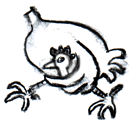DNA computer plays tic-tac-toe
 'DNA computer' is unbeatable at tic-tac-toe - tech - 17 October 2006 - New Scientist Tech: "A computer that uses strands of DNA to perform calculations has mastered the game tic-tac-toe.
'DNA computer' is unbeatable at tic-tac-toe - tech - 17 October 2006 - New Scientist Tech: "A computer that uses strands of DNA to perform calculations has mastered the game tic-tac-toe.MAYA-II, developed by researchers at Columbia University and the University of New Mexico in the US, uses a system of DNA logic gates to calculate its moves.
A DNA logic gate consists of a strand of DNA that binds to another specific input sequence. This binding causes a region of the strand to work as an enzyme, modifying yet another short DNA sequence into an output string.
...A human plays MAYA-II by adding a DNA sequence that represents their chosen move at a particular point in the game. This is added to all 8 wells that correspond to the outer squares on a tic-tac-toe grid. One limitation of the system is that the human player must always go second, after the centre square has been filled by the machine.
...Each well contains between 14 and 18 DNA logic gates. After a human player makes their move, MAYA-II responds through a DNA reaction. The strand outputted feeds into a series of other DNA logic gates that link the different wells. This results in a chemical reaction that generates a green fluorescent glow in the square MAYA-II selects as its next move. The strand also interacts with the remaining wells, priming them to respond appropriately to future moves."



0 Comments:
Post a Comment
<< Home